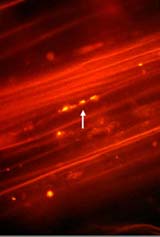Bugs dress salad

Fluorescent labelled E. coli O157:H7 lurk inside lettuce. <br>© Karl Matthews, Rutgers University
Harmful bugs may lurk within leaves.
Healthy salad greens could be contaminated with bacteria that cause food poisoning, despite thorough rinsing. New research shows that harmful bugs can enter lettuce plants through its roots and end up in the edible leaves1.
Although uncommon, food poisoning caused by eating plants can occur. Vegetables that are fertilized with animal manure, which can contain pathogens, pose the biggest threat. Raw salad vegetables are now washed after harvesting to reduce the risk of contamination.
After an outbreak of poisoning by the potentially fatal O157:H7 strain of Escherichia coli that was connected with prewashed letuce2, food microbiologist Karl Matthews and colleagues at Rutgers University in New Jersey investigated whether bacteria were getting inside the lettuce, rather than just sitting on the leaves. The team grew lettuce in manure inoculated with E. coli O157:H7.
After sterilizing the plants’ surface with bleach, the researchers still found bacteria within the internal tissues that are used for water transport. Lettuce leaves could be infected by simply irrigating plants with bacteria-inoculated water, despite the fact that foliage did not come into direct contact with the water. Small gaps in growing roots are a known port of entry for plant pathogens, and may allow E. coli to get in, the researchers suspect.
Water used to irrigate fields could pose an infection risk, warns Matthews. Although the use of composting manure is regulated, “if you’re using surface irrigation there’s still a chance that the edible portion of the plant can be contaminated”, he says.
“No one has checked to see whether [bacteria] are on the surface of the plant or within,” agrees William Waites, a food microbiologist at the University of Nottingham, UK. His group’s research reveals a similar uptake of E. coli O157:H7 and Listeria bacteria by spinach. Bacteria also accumulate in the plants over time, the group found. “Levels increased up to 30 days, around the time the plants would be harvested,” says Waites.
The concentrations of bacteria used in the lab experiments are probably far higher than those that occur on farms, Matthews points out – after all, poisoning by salad is not common. The team is now working to establish whether salad vegetables grown on farms are also contaminated by E. coli O157:H7 or by other bugs.
“If it is found in saleable plants, it presents us with a new vehicle for E. coli O157:H7,” says Tom Cheasty, who directs E. coli O157:H7 surveillance at the UK Public Health Laboratory Service in London. But he adds that, for the moment, there is no compelling reason to treat salad with suspicion.
References
- Solomon, E. B., Yaron, S. & Matthews, K. R. Transmission of Escherichia coli O157:H7 from contaminated manure and irrigation water to lettuce plant tissue and its subsequent internalisation. Applied and Environmental Microbiology, 68, 397 – 400, (2002).
- Hillborn, E. D. et al. A multistate outbreak of Escherichia coli O157:H7 infections associated with consumption of mesclun lettuce. Archives of Internal Medicine, 159, 1758 – 1764, (1999).
Media Contact
More Information:
http://www.nature.com/nsu/020101/020101-10.htmlAll latest news from the category: Health and Medicine
This subject area encompasses research and studies in the field of human medicine.
Among the wide-ranging list of topics covered here are anesthesiology, anatomy, surgery, human genetics, hygiene and environmental medicine, internal medicine, neurology, pharmacology, physiology, urology and dental medicine.
Newest articles

First-of-its-kind study uses remote sensing to monitor plastic debris in rivers and lakes
Remote sensing creates a cost-effective solution to monitoring plastic pollution. A first-of-its-kind study from researchers at the University of Minnesota Twin Cities shows how remote sensing can help monitor and…

Laser-based artificial neuron mimics nerve cell functions at lightning speed
With a processing speed a billion times faster than nature, chip-based laser neuron could help advance AI tasks such as pattern recognition and sequence prediction. Researchers have developed a laser-based…

Optimising the processing of plastic waste
Just one look in the yellow bin reveals a colourful jumble of different types of plastic. However, the purer and more uniform plastic waste is, the easier it is to…



